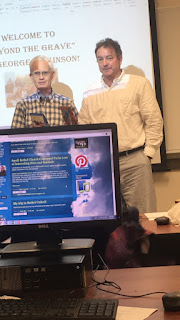According to Wikipedia, PAS is often confused with euthanasia (sometimes referred to as "mercy killing") in that euthanasia involves a physician administering the means of death, usually a lethal drug. In PAS, the patient self-administers the means of death.
 |
| Dr. George Dickinson (left) and Patrick Harwood Photo by Bridgette Johnson |
An international expert on the study of death, dying and other "end of life" issues, Dickinson says in coming years he can envision more states approving Physician Assisted Suicide.
"It comes down to sanctity of life versus quality of life," Dickinson told CofC students on April 3. Speaking to Patrick Harwood's First Year Experience course "Beyond the Grave: What Old Cemeteries Tell and Teaching the Living," Dickinson said sanctity of life supporters oppose any type of assisted death because to them, "God has given me this body, who am I to destroy it?"
Those who support the quality of life position say those suffering incurable, painful diseases and illnesses should have a "get me out of this" alternative, as Dickinson put it.
Along with Colorado other states that in recent years approved PAS are California, Oregon, Washington, Montana and Vermont. Last fall, Minnesota lawmakers dropped a bill to introduce PAS in their state after impassioned hearings on both sides of the controversial issue. In 2012, Massachusetts voters rejected a "death with dignity" proposal by 51-to-49 percent.
Is PAS a blue state, red state issue? Perhaps, Dickinson said. "Different cultures deal with death differently," he said. "African-Americans, for example, tend toward a sanctity of life philosophy."
Dickinson said he became interested in studying end of life issues in the 1970s after asking a third year medical student at the University of Minnesota, "How's your death and dying course? I nearly fell out of my chair when he said he hasn't taken one."
A 1976 inquiry to America's then 113 medical schools by Dickinson found that only seven offered a death and dying course. Thanks to the advocacy by Dickinson and others, today's 136 U.S. medical schools offer at least something on death and dying.
Among other noteworthy topics discussed by Dickinson in the presentation he titled "The American Way of Death":
- 80 percent of Americans now die in institutional settings, away from their homes
- Today, 45 percent of people who die in the Charleston area are cremated, up from 10 percent in the 1970s
- By 2025, Dickinson expects that cremation figure to rise to 50 percent
- The average earth burial today in the U.S. costs around $10,000 when embalming, caskets, burial vaults and gravesite costs are added
- Cremations, on average, cost $1,200-$1,500
- Dickinson said many in Europe, where cremation is much more popular, "think we are crazy" in the U.S. for our expensive and elaborate funeral and burial rituals
- The British, Dickinson said, are much more community oriented than Americans in terms of having an extensive network of free standing hospices, where people with terminal illnesses can go to die
- Americans have many euphemisms for death that are used to avoid its harsh realities
- In 1900, the major causes of death (etiology) in America were pneumonia and tuberculosis and that today it is heart disease (followed fairly closely by cancer, then chronic lower respiratory diseases and accidents due to unintentional injuries) and strokes
- Death Cafes are a trend in America- these are places and events where people can come together and talk about death and dying in a relaxed atmosphere
- Dickinson recently has expanded his research to include veterinarians who euthanize dogs, cats and horses
- From vets and others, he has collected stories about how dogs and cats seem to, literally, be able to smell death before it happens. He told a story about a Rhode Island nursing home where, if a cat got on a patient's bed, that person would die in six hours

No comments:
Post a Comment